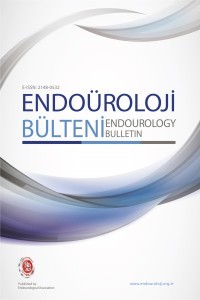Üreteral Yaralanma, İmpakte Taşlara Üreteroskopik Litotripsi Sırasında Üreter Duvar Kalınlığı ile Artmaktadır
Üreter yaralanması, impakte taş, üreteroskopi
Ureteral Injury Increases with Ureteral Wall Thickness During the Ureteroscopic Lithotripsy of Impacted Stones
___
- 1. Traxer O, Thomas A (2013) Prospective evaluation and classification of ureteral wall injuries resulting from insertion of a ureteral access sheath during retrograde intrarenal surgery. J Urol 189(2):580-4. https://doi:10.1016/j.juro.2012.08.197
- 2. Schoenthaler M, Wilhelm K, Kuehhas FE, Farin E, Bach C, Buchholz N, Miernik A (2012) Postureteroscopic lesion scale: a new management modified organ injury scale--evaluation in 435 ureteroscopic patients. J Endourol 26(11):1425-30. https://doi:10.1089/end.2012.0227
- 3. Schoenthaler M, Buchholz N, Farin E, Ather H, Bach C, Bach T, Denstedt JD, Fritsche HM, Grasso M, Hakenberg OW, Herwig R, Knoll T, Kuehhas FE, Liatsikos E, Liske P, Marberger M, Osther PJ, Santos JM, Sarica K, Seitz C, Straub M, Traxer O, Trinchieri A, Turney B, Miernik A (2014) The Post-Ureteroscopic Lesion Scale (PULS): a multicenter video-based evaluation of inter-rater reliability. World J Urol 32(4):1033-40. https://doi: 10.1007/s00345-013-1185-1
- 4. Guzelburc V, Guven S, Boz MY, Erkurt B, Soytas M, Altay B, Albayrak S (2016) Intraoperative Evaluation of Ureteral Access Sheath-Related Injuries Using Post-Ureteroscopic Lesion Scale. J Laparoendosc Adv Surg Tech A 26(1):23-6. https://doi: 10.1089/lap.2015.0294
- 5. Sarica K, Kafkasli A, Yazici Ö, Çetinel AC, Demirkol MK, Tuncer M, Şahin C, Eryildirim B (2015) Ureteral wall thickness at the impacted ureteral stone site: acritical predictor for success rates after SWL. Urolithiasis 4 (1):83-8. https://doi: 10.1007/s00240-014-0724-6.
- 6. Elibol O, Safak KY, Buz A, Eryildirim B, Erdem K, Sarica K (2017) Radiological noninvasive assessment of ureteral stone impaction into the ureteric wall: A critical evaluation with objective radiological parameters. Investig Clin Urol 58(5):339-345. https://doi: 10.4111/icu.2017.58.5.339
- 7. Coleman S.L., Monga M (2015) Difficult Case: The Impacted Ureteral Stone. In: Patel S., Nakada S. (eds) Ureteral Stone Management. Springer, Cham
- 8. Morgentaler A, Bridge SS, Dretler SP (1990) Management of the impacted ureteral calculus. J Urol 143:263–6.
- 9. Mugiya S, Maruyama S, Hadano S, Nagae H (2004) Endoscopic features of impacted ureteral stones. J Urol 171:89–91
- 10. Huffman JL, Bagley DH, Lyon ES (1985) Abnormal ureter and intrarenal collecting system. In: Urologic endoscopy: a manual and atlas. Boston: Little Brown and Co, pp 59–73. Chapter 6.
- 11. Perez Castro E, Osther PJ, Jinga V, Razvi H, Stravodimos KG, Parikh K, Kural AR, de la Rosette JJ (2014) CROES Ureteroscopy Global Study Group. Differences in ureteroscopic stone treatment and outcomes for distal, mid-, proximal, or multiple ureteral locations: the Clinical Research Office of the Endourological Society ureteroscopy global study. Eur Urol. 66(1):102-9. https://doi: 10.1016/j.eururo.2014.01.011.
- 12. Chew B.H., Paterson R.F., Lange D (2015) Ureteral Stents. In: Patel S., Nakada S. (eds) Ureteral Stone Management. Springer, Cham
- Yayın Aralığı: Yılda 3 Sayı
- Başlangıç: 2020
- Yayıncı: ENDOÜROLOJİ DERNEĞİ
Supin Perkütan Nefrolitotomi-Eski Köye Yeni Adet
Dünden Bugüne Radikal Perineal Prostatektomi: Açık, Perineoskopik, Robotik
Yusuf İlker ÇÖMEZ, Doğukan SÖKMEN, Volkan TUĞCU
Mustafa BOZ, Vahit GÜZELBURÇ, Gökhan ÇALIK, Mustafa SOYTAŞ, Çağrı KAÇTAN, Selçuk GÜVEN
Bir Bakışta Üriner Sistem Taş Hastalığına Metabolik Yaklaşım
Yazılım Destekli Manyetik Rezonans Ultrason Füzyon Biyopsi Tekniklerine Güncel Bakış
Selahattin BEDİR, Engin KAYA, Serdar YALÇIN, Murat ZOR
Robot Yardımlı Laparoskopik Retroperitoneal Parsiyel Nefrektomi
Mahmut Taha ÖLÇÜCÜ, Kayhan YILMAZ, Mutlu ATEŞ
Prostat Kanseri Tedavisinde Fokal Tedaviler
Prostat Enükleasyonunda Lazer Savaşları : Holmium vs Thulium Lazer
Mehmet YILMAZ, Engin KAYA, Eymen GAZEL, Serdar YALÇIN, Sercan YILMAZ, Halil Çağrı AYBAL, Lütfi TUNÇ
Mustafa Bilal TUNA, Tünkut DOĞANCA, İlter TÜFEK, Can ÖBEK, Ali Rıza KURAL
